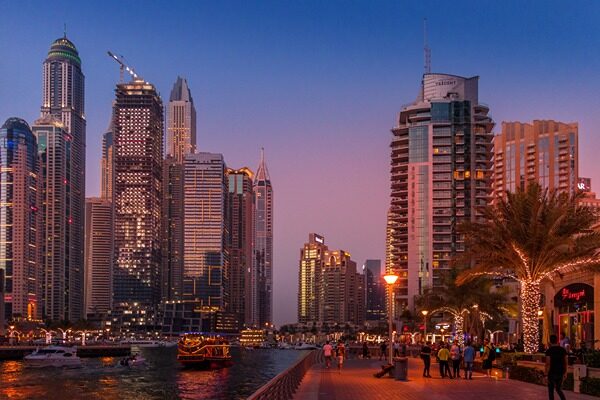Expo 2020 Dubai: Connecting Minds, Creating the Future

The city of Dubai at sunset
In 2021, I had the opportunity to intern in Dubai at Mobius Capital Partners, an asset-management company focused on emerging markets and environmental, social, and governance (ESG) issues. While in Dubai, I learned that the World Expo, which had been postponed due to COVID, would be held October 1, 2021 through March 31, 2022. I decided to go back to visit Expo 2020 in December 2021.
International Registered Exhibitions, better known as World Expos, are a global gathering of countries from around the world that focus on a universal theme. Usually the theme is related to a globally pressing challenge. Expo 2020 focused on three major themes: opportunity, mobility, and sustainability.
The importance of sustainability at Expo 2020
I had the opportunity to meet with Dina Storey, the director of sustainability for the Dubai Expo, to learn more about how the UAE created the most sustainable Expo yet. Storey told me how she focused on integrating sustainability throughout the entire Expo, and measured and reported on the impact created. For example, all permanent buildings that were erected for the Expo needed to meet the LEED gold standard or higher, and all temporary buildings had to submit a plan for recycling or dismantling their parts before the start of construction.
Any emissions caused by these structures have been accounted for, from the construction to the dismantling phases, although structures for which the Expo is not solely responsible are not included. For example, the emissions caused by the Expo 2020 metro station were logged, as the station was built for the sole purpose of the Expo, but the rail was not accounted for since it was already being built to extend the metro line to the new DWC Airport.
The Food Rescue Programme is an example of one of the many sustainable initiatives implemented at the Dubai Expo. This program focused on mitigating the issue of excessive food waste and measuring the carbon impact of reducing the food waste.
These sustainability programs created a foundation for the United Arab Emirates’ Regulatory Indicators for Sustainable Energy (RISE) document, which Storey helped publish. The purpose of this document was to take various initiatives that were implemented at the Expo and spread those standards throughout the UAE.
How ESG themes shaped Expo 2020
The past several Expo themes have been related to ESG issues and have particularly focused on the sustainability aspect of ESG. This Dubai Expo took a holistic approach to ESG, touching on social and governance issues as well incorporating mobility and opportunity alongside sustainability.
The layout of the Expo was created with accessibility in mind for those who are handicapped. There was also a guide who rated pavilions based on sensory levels to ensure that people with sensory overload issues could avoid anything that may cause irritation. There were even tactile maps and relief areas for service dogs aimed at allowing as many people as possible to experience the Expo, regardless of physical ability.
The sustainability district also hosted a women’s pavilion, which explored the role of women throughout history and their impact on our society. Additionally, 80 percent of the leadership team for the Expo were women. It’s clear that accessibility and inclusivity were very important to the Expo team.
How have ESG standards from the Expo been adapted in the UAE?
ESG is not a one-size-fits-all approach. The UAE is a developing nation with a completely different climate from the EU. It did not make much sense to implement the EU Eco label, which identifies certain products as sustainable, in the UAE, because something considered biodegradable in the EU may not be biodegradable in the desert climate of the UAE. Therefore, the UAE created its own Eco label, and the RISE document was adjusted to better fit the needs of the UAE’s supply chain.
The Dubai Electricity & Water Authority had a pavilion at the Expo and it was interesting to see the sustainable projects they were working on, including Al Shera’a, which will be the world’s largest and smartest government net-zero emissions building. They are even working on creating a hydropower plant in the desert, which will be able to store energy from solar panels during the day for use at night.
Emerging markets presence at Expo 2020

Expo 2020 was the most international and inclusive World Expo. Altogether, 192 countries participated, including many emerging and frontier markets. Emerging market countries’ pavilions, including those of Egypt, Brazil, and India, displayed economic data about their countries such as their main exports.
Many of the emerging market pavilions were massive and beautifully designed, created to be permanent buildings that will be a part of District 2020. Frontier markets tended to have smaller pavilions, though they also placed an emphasis on their economy and local products. Another marked difference was that while emerging countries advertised their country to investors, developed countries rarely focused on or mentioned investing.
District 2020: The future of Expo 2020
One aspect of Expo 2020 that differentiates it from others is that after the exhibition closed it transitioned into a smart city known as District 2020. During the construction of the Expo, there was a greater emphasis on and consideration of the future District 2020 rather than the Expo itself. District 2020 will become an inclusive and diverse hub for individuals, startups, and businesses to connect and innovate together. It will be powered by IoT and 5G and have autonomous vehicle routes available for use.

